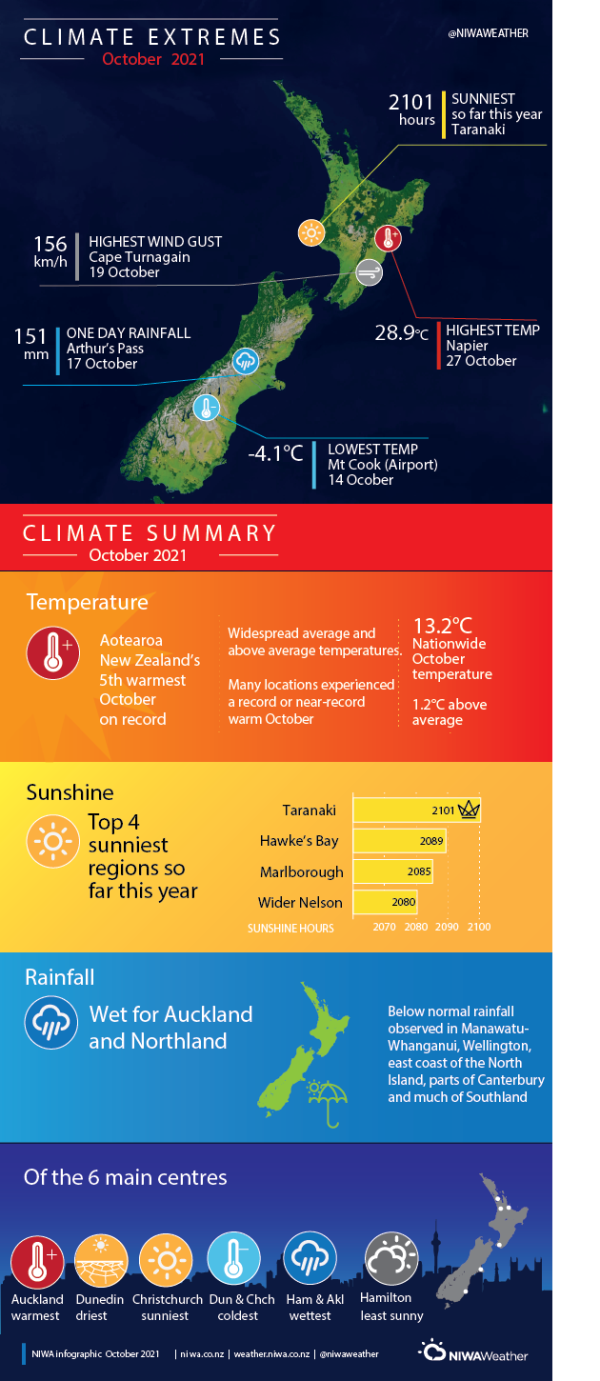5th-warmest October on record
|
Temperature |
It was Aotearoa New Zealand’s 5th warmest October on record. Temperatures were above average (0.51°C to 1.20°C above average) to well above average (>1.20°C above average) for the majority of the country. The exceptions were parts of Marlborough and coastal Canterbury where temperatures were near average (±0.50°C of average). |
|
Rainfall |
Rainfall was well above normal (>149% of normal) in large parts of Northland and Auckland. Rainfall was above normal (120-149% of normal) in the Coromandel, coastal Bay of Plenty, coastal Taranaki, northern Tasman, an area near Christchurch, and southern Canterbury/northern Otago. Conversely, below normal (50-79% of normal) and well below normal (<50% of normal) rainfall was observed in Manawatū-Whanganui, Wellington, most of the east coast of the North Island, northern and central Canterbury, Fiordland, and much of Southland. |
|
Soil Moisture |
At the end of the month, and for the time of year, soil moisture levels were lower than normal in eastern Wairarapa as well as parts of Canterbury, Otago and Southland. Soil moisture was higher than normal in Auckland, Northland, the Bay of Plenty and parts of Waikato and Marlborough. Soil moisture was near normal elsewhere. |
Overview
As is often the case, October weather patterns were changeable. Periods of high pressure and calm weather were interspersed with unsettled and active weather. For the month as a whole, air pressure was higher than normal south and east of Aotearoa New Zealand, with lower than normal pressure in the western Tasman Sea. This atmospheric pattern was consistent with a developing La Niña in the tropical Pacific and was associated with more northerly and north-easterly air flows than normal over New Zealand.
Winds from the north brought frequent warm and humid conditions and were a key driver behind the warm month alongside warmer than normal coastal waters. Many locations experienced a record or near-record warm October, particularly when looking at overnight minimum temperatures. Overall, the nationwide average temperature for October 2021 was 13.2°C (1.2°C above the 1981-2010 October average) making it New Zealand’s 5th-warmest October on record since NIWA’s seven station temperature series began in in 1909.
The warmth for the month as a whole occurred despite occasional cold snaps. Brisk southerlies mid-month saw Paraparaumu and Ngawi experiencing a near-record cold October day on the 13th. Conversely on 26 October, a warm and humid northerly air flow led to several North Island locations experiencing near-record warm temperatures during the day as well as record and near-record warm temperatures overnight (see the highlights and extreme events section for more details).
Rainfall patterns across the country were mixed. For Northland and Auckland, rainfall was well above normal (>149% of normal) for large parts of the regions. Both Kerikeri and Kaikohe observed more than three times their normal October rainfall amount, resulting in their wettest October on record (with records extending to 1935 and 1956 respectively). This was influenced by a persistently wet Labour weekend, as well as thunderstorms and localised heavy rainfall events earlier in the month.
Rainfall was above normal (120-149% of normal) in the Coromandel, coastal Bay of Plenty, coastal Taranaki, northern Tasman, an area near Christchurch, and southern Canterbury/northern Otago. It was an active end of the month for the Bay of Plenty, Hawke’s Bay and Marlborough where thunderstorms on 28 and 29 October led to heavy downpours and localised flooding. Reported damage was worst in Marlborough where many homes and businesses were flooded.
Conversely, dry conditions were observed during October in Manawatū-Whanganui, Wellington, most of the east coast of the North Island, northern and central Canterbury, Fiordland, and much of Southland. Tiwai Point in Southland experienced its third-lowest October rainfall total since records began in 1970.
Further Highlights:
- The highest October temperature was 28.9°C, observed at Napier on 27 October.
- The lowest October temperature was -4.1°C, observed at Mt Cook (Airport) on 14 October.
- The highest 1-day rainfall was 151 mm, recorded at Arthur’s Pass on 17 October.
- The highest wind gust was 156 km/h, observed at Cape Turnagain on 19 October.
- Of the six main centres, Auckland was the warmest, Dunedin was the driest, Christchurch was the sunniest, Hamilton was the least sunny, Dunedin and Christchurch were the coldest and Hamilton and Auckland were the wettest.
- Of the available, regularly reporting sunshine observation sites, the sunniest four regions in 2021 so far are Taranaki (2101 hours), Marlborough (2089 hours), Hawke’s Bay (2085 hours), and Wider Nelson (2080 hours).
Download
Climate Summary - October 2021
Climate Statistics - October 2021 [PDF 160KB]


